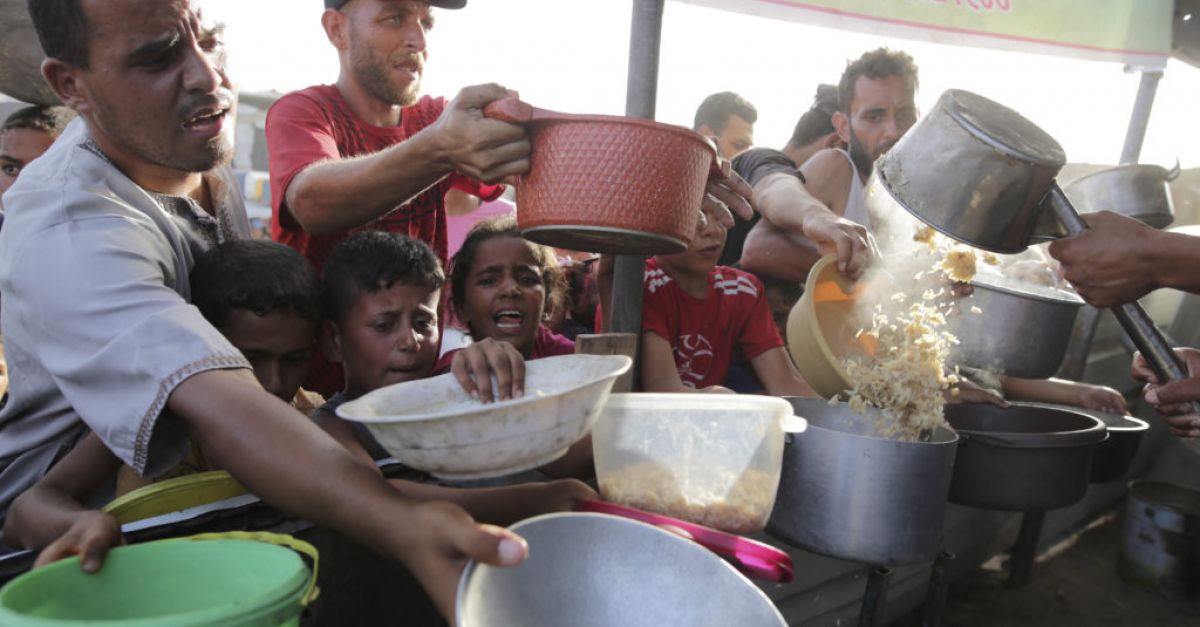Six years ago, Love Connections Dog Rescue worker Heather Nicely would have said the hardest part of her job was making a decision between fundraising $20,000 for a dog who had been hit by a car, who may never have a great quality of life again, or euthanizing them.
Now, the emotional drain of her work has skyrocketed amidst what feels like a never-ending cycle of taking in shelter dogs on euthanasia deadlines, preventing more animals from being left at shelters and rehoming dogs to be able to save more.
“It feels like no matter how many dogs you save, there’s still that many more that are showing up on our feet that are dead,” Nicely said.
Rescues, shelters and volunteers are all struggling to combat an ongoing animal homelessness crisis in Maricopa County, and the state as a whole.
In 2021, Maricopa County Animal Care and Control had an average inventory of 503 animals per day. So far in 2024, the average daily inventory is 790 animals, according to communications supervisor Kim Powell.
With the increase in the number of animals under their care, Maricopa County Animal Care and Control has also seen a significant increase in the length of time dogs stay at the shelter. Their average nine-day length of stay has increased to 17 days, Powell said.
On Monday morning, MCACC’s West Shelter location had 850 dogs in its care. The shelter’s capacity is 650 dogs.
How is MCACC adjusting to increase in dogs?
With 200 more dogs than the shelter has space for, MCACC is implementing a number of changes in an attempt to combat the ongoing overcapacity crisis, including waiving adoption fees during July.
In partnership with BISSELL Pet Foundation, the shelter is holding an “Empty the Shelters” event where all adoption fees will be waived for dogs six months and older from July 3-31. The goal, Powell said, is to get as many dogs to their forever homes as possible and open space up for incoming strays or lost dogs.
Another change the shelter may have to make when its numbers are so high is modifying kennel spaces to make room for more dogs. This can mean sharing a kennel between two dogs if it’s safe or splitting larger kennels in half to make space for an extra dog, Powell said.
The kennels that are split are the outdoor kennels, which have one-half inside and one-half outside, connected by a small opening. When they are split to house two dogs, one dog remains outside for up to three days at a time.
Precautions are taken to keep the outdoor dog safe, Powell said, including misting and air systems. However, splitting kennels brings another issue as dogs experience more stress in the smaller spaces.
Powell said MCACC has also changed its criteria for which dogs are added to the priority placement portal—the list of dogs with euthanasia deadlines. Changing the priority portal criteria happened when the shelter reached 750 dogs and will be returned to normal criteria when it is back to capacity.
The goal of the portal, Powell said, is to tell the community which dogs need immediate placement.
“They’re put on our portal which then allows our New Home partners to see these dogs and pull them, which means they get them out of here and take them to different rescue groups,” said Samantha Thurman, MCACC’s Chief Animal Medical Officer. “If they do not get pulled, after they’ve been given that deadline that’s when the euthanasia would happen.”
In 2022, 10.2% of the dogs taken in ended up on the priority placement portal. So far, in 2024, 12.76% of intakes were put into the portal.
Even with the increase in intakes, MCACC has maintained an annual average save rate of 95%, which refers to the number of dogs who are not euthanized.
Dogs on the priority placement list are often adopted quickly or picked up by local rescue shelters, which can give the dogs the extra resources they need, Powell said.
How has criteria changed for the priority placement portal?
Normally, dogs are added to the priority placement portal if they are sick and have not responded to treatment in 14 days or if they have dangerous behavioral tendencies.
Dogs with deadlines for behavioral reasons are given a five-day deadline, Powell said, while dogs with medical conditions range from three to nine days depending on the severity of the condition.
As of Monday, changes to the criteria are for dogs with bites on their records that are otherwise adoptable or the dog has proof in its history that it cannot safely be around other dogs.
The high-stress environment of an overcrowded shelter leads to more behavioral and health problems for the dogs, and puts employees at risk, Powell said.
“A dog that already has a bite history, chances are they could bite again, and therefore, in this high-stress environment, it could become a safety risk for our staff,” Powell said.
“There are so many dogs here, and in the stressful environment, it puts other dogs and people at risk.”
Making the decision to change the priority portal criteria was heartbreaking for the staff, Powell said.
“It’s just not a great position to be in and it’s really heartbreaking on everyone when you have to put a deadline on a dog, but let alone go through that euthanasia process because we all get to know the dogs here,” Powell said. “We all love them.”
Keeping dogs in the high-stress environment is harmful to the dogs’ physical and mental health, Thurman said. For sick dogs, the isolation process in an overcrowded shelter often leads to worsened health conditions and the spreading of illnesses.
“Part of the concern is the thought process of euthanizing for space, which we’re definitely not doing,” Thurman said. “If we can’t appropriately isolate them, then no one’s going to get healthy. And then you have the stress of being in the shelter that weakens their immune system.”
As tension runs high at the shelter, two dogs were taken out of surgery under anesthetics last month because of a threat made against the organization, Powell said. According to a Facebook post by MCACC, both dogs were doing well and all animals at the shelter were safe.
Local rescue partners also struggle to take on more dogs
MCACC partners with several local animal rescue organizations through their New Hope Program, which strives to help the dogs on priority placement receive the support they need and find a home.
However, as the ongoing capacity crisis builds in Maricopa County, the rescue groups are also struggling to take more dogs. This has made the work extremely stressful, local rescue founder Alison Nicolosi said.
“I hate it right now because I go down there, and I, physically in-person, meet some of these dogs that are on the e-list, and they’re good dogs,” said Nicolosi, the founder of AZ Husky Rescue.
“They’re really good dogs. They just need a specific home. Those temporary changes they’ve made have stressed out a lot of the rescue partners right now.”
Nicely, who works in operations and public relations for Love Connections Dog Rescue, said that while working in rescue has never been easy, the capacity crisis has made it significantly harder.
Volunteers are running out of the emotional, mental and physical capacity the work requires, Nicely said.
“We are taking in more dogs than what is at our capacity, which means that we’re doing a lot more driving, we’re doing a lot more care we’re doing a lot less sleeping,” Nicely said.
No matter how many dogs you save, there are always more, Nicely said. “We just have to keep trying to go until it breaks us.”
What is causing the overcapacity crisis?
The crisis has been built by multiple issues, Powell said, including a lack of spaying and neutering, a lack of identifying and tracking dogs and abandonment.
One of the primary causes behind the overcapacity crisis is that owners are not spaying or neutering their pets, Powell said. This means that more puppies are being born, often accidentally than people can care for.
There has also been a nationwide shortage of veterinarians, Powell said, making it harder for owners to spay or neuter their pets and also causing longer wait times for spay and neuter surgeries within the shelter.
Neutering or spaying your animals is one of the biggest ways individuals can help the crisis, Powell said.
Unneutered male dogs are also more likely to run away, Powell said. Lost and stray dogs are another large contributor to the shelter’s population.
The shelter receives a lot of intakes without microchips or identification tags. According to Powell, only 13% of lost dogs are returned to their owners.
What can you do to help?
Powell said pet owners can microchip their pets, so if they are lost, it is easy to locate their family.
MCACC is offering free microchipping until the end of the year in hopes of combating this problem.
As the Fourth of July approaches, Powell stressed the importance of identifying your pet. The holiday is one of the shelter’s busiest times of the year as dogs are more likely to run away in fear of fireworks.
“Even if you think, oh my dog never ran away the previous year, don’t just assume that they’re not going to run away this year,” Powell said.
“If you know your dog is afraid of fireworks or if you’re just not sure, go outside with them, keep an eye on them. Make sure that they’re wearing their collar and ID tag and make sure they have a microchip. Just make sure that they are prepared, and you are prepared if they run off.”
A lack of resources is another contributor to the overall crisis. Although Maricopa County’s population has increased greatly in recent years, the county has not expanded the shelters to a level that would accommodate the need.
A second MCACC shelter opened in the East Valley in May with the goal of moving dogs quickly and reducing the average stay time, but there are still not enough kennels for all of the dogs they take in, Powell said.
She said the county Board of Supervisors recently approved funding for a new West Valley shelter that will increase the overall capacity.
One of the best ways individuals can help the crisis currently is by adopting and fostering dogs. Fostering, in particular, is a huge help, Nicolosi said.
It is often harder to find fosters than adopters, Nicolosi said, as people who can’t commit to adoption can overestimate the commitment needed to foster. There are many options for fostering, from long-term commitments to vacation fosters.
Nicolosi said vacation fosters refer to people who briefly watch a dog in a long-term foster while the foster is away.
Individuals can also help by participating in MCACC’s “Tails Around Town” program, in which participants take a dog for the day to get them out of the shelter and in the view of potential adopters.
“It’s a community issue,” Powell said. “It is hard work. There’s an overwhelming amount of dogs in the Phoenix area alone, let alone in Northern Arizona and other states. It’s a big problem. But if we all work together, I think that we can come up with a big solution.”
This article originally appeared on Arizona Republic: Maricopa County animal shelters, rescues struggle from overcapacity
Signup bonus from




